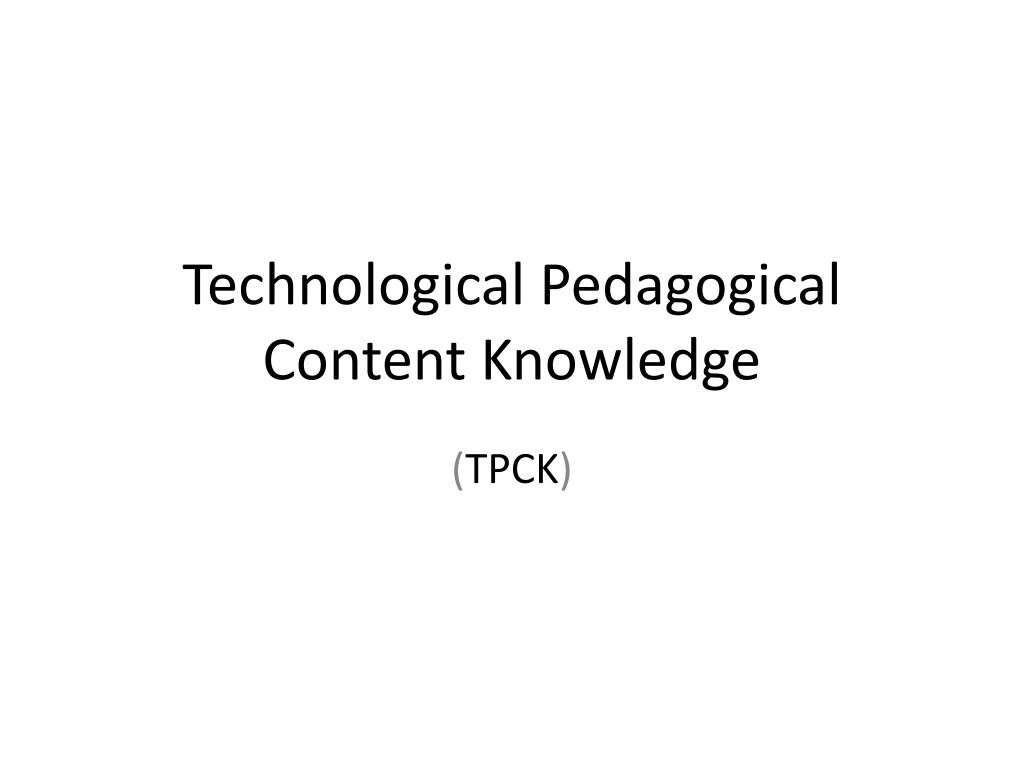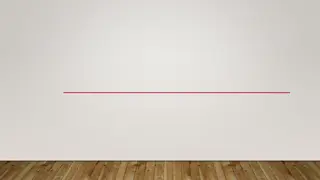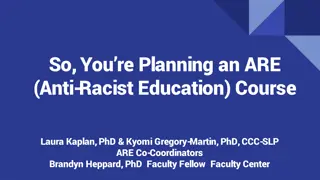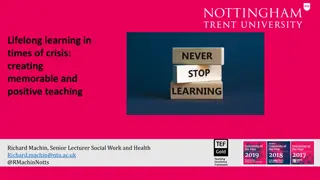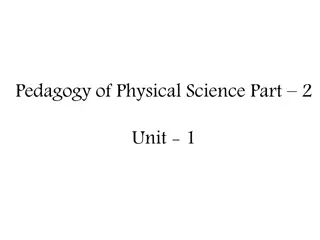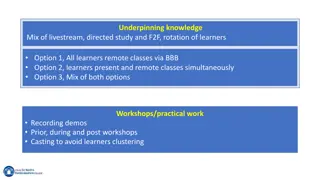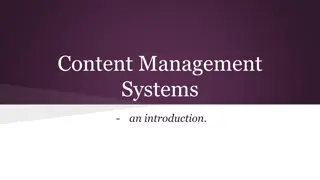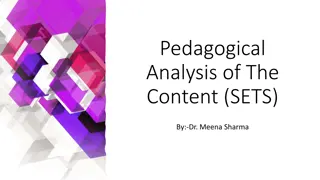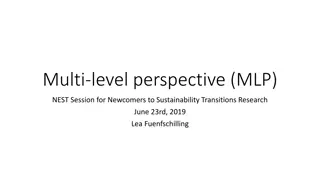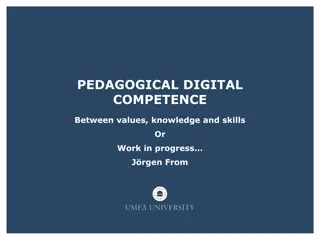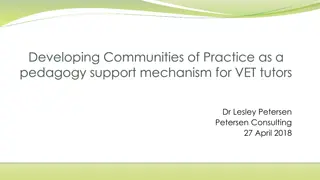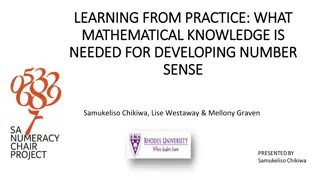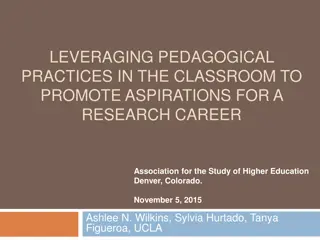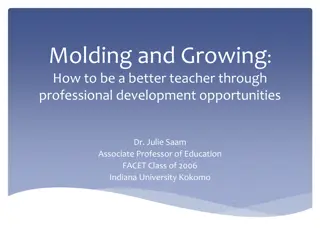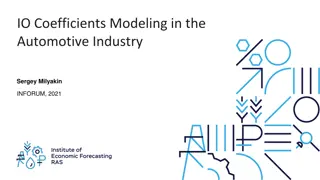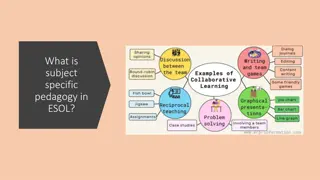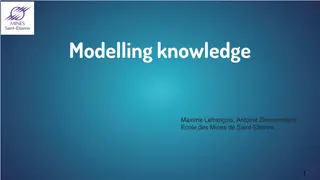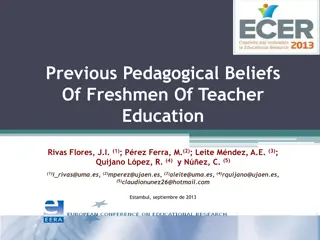Understanding Technological Pedagogical Content Knowledge (TPCK)
Technological Pedagogical Content Knowledge (TPCK) is a framework developed by Punya Mishra and Matthew J. Koehler that integrates content, pedagogy, and technology for effective teaching. TPCK emphasizes the interaction between these three key components to enhance technology integration in education, encompassing content knowledge, pedagogical knowledge, and technology knowledge. This framework equips educators with the necessary skills to successfully integrate technology in the classroom, enhancing student learning experiences.
Download Presentation

Please find below an Image/Link to download the presentation.
The content on the website is provided AS IS for your information and personal use only. It may not be sold, licensed, or shared on other websites without obtaining consent from the author. Download presentation by click this link. If you encounter any issues during the download, it is possible that the publisher has removed the file from their server.
E N D
Presentation Transcript
Technological Pedagogical Content Knowledge (TPCK)
Technological Pedagogical Content Knowledge : A Framework for Teacher Knowledge Punya Mishra and Matthew J. Koehler
With Punya Mishra and Matthew J. Koehler
What is TPCK? A framework for teacher knowledge for technology integration into the Pedagogical content knowledge (PCK). Three bodies of knowledge : content, pedagogy and technology interact (in abstract and in practice) to produce the type of knowledge needed to successfully integrate technology in the classroom. VIDEO:
The TPCK Framework and component Content knowledge context Technological knowledge Pedagogical knowledge
Content Knowledge Content knowledge is knowledge about the actual subject matter that is to be learned or taught. Knowledge of concepts, theories, ideas, organizational frameworks, knowledge of evidence and proof
Pedagogical knowledge Pedagogical knowledge is deep knowledge about the processes and practices or methods of teaching and learning and encompasses overall educational purposes, values, and aims. Knowledge of student learning, classroom management, lesson plan development and implementation, and student evaluation Requires an understanding of cognitive, social and developmental theories of learning and how to apply to students in the classroom
Technology knowledge Technology knowledge is always in a state of flux : technology continually changes. Keeping up to date with it a full-time job E.g digital technology (video, internet, computers, peripheral devices) Software tools (word processing, email and spreadsheets) Application (apps), blogs and wikis, podcasting, tagging/social bookmarking Gaming technologies
Pedagogical Content Knowledge Knowledge of pedagogy that is applicable to the teaching of specific content PCK covers the core business of teaching, learning, curriculum assessment, and reporting, such as the conditions that promote learning and links among curriculum assessment, and pedagogy. PCK is the notion of transformation of the subject matter for teaching
Technological content knowledge An understanding of the manner in which technology and content influence and constrain one another. Teachers need to understand which specific technologies are best suited to addressing subject-matter learning in their domains, and how the content dictates or perhaps even changes the technology or vice versa
Technological pedagogical knowledge An understanding of how teaching and learning changes when particular technologies are used E.g. web-based technologies such as blogs or podcasts are designed for purposes of entertainment/communication/social networking, teachers need to be creative, open- minded and forward-looking to reconfigure it for their own pedagogical purposes
Technological pedagogical content knowledge An understanding that emerges from an interaction of content, pedagogy and technology knowledge. TPCK requires teachers as curriculum designers
Goals of the TPCK Course To develop in Teacher Candidate the strategic thinking involved in TPCK the thinking that involves PLANNING, ORGANISING, CRITIQUING & ABSTRACTING for specific content, specific student needs, and specific classroom situation. To guide TC in planning lessons, units and sequences of instructions To have TC monitor their progress in their development of the KNOWLEDGE, SKILLS & DISPOSITION of TPCK through Reflections: the reflections is a challenge to improve the lesson, the strategies and the assessments.
Strategy to guide TC in the development of TPCK Collaborative Study Group Form a group of 3 or 4 TCs according to School level : Primary, Secondary, Voctech, HE by different content area : Language, Art, Social Studies, Maths, Science, PE
Tasks of the 21st Century Teacher Teachers of the 21st century must be prepared to redesign and create a curriculum and instruction to prepare their students with the skills of a twenty-first century literate citizen: New communication and information skills, the ability to think critically and creatively in problem-solving and decision-making situation. Acquire 21st century learning design 21CLD skills such as KNOWLEDGE BUILDING, USE OF ICT, COLLABORATION, REAL WORLD PROBLEM SOLVING, SELF-REGULATION
Challenges for 21st Century Teacher Integrating technology with the content and pedagogical issues and concerns. e.g. elementary pre-service teacher must deal with issues of engaging children in digital story telling (an experience they themselves have not had) E.g mathematics teachers faced with questions about when and how students should use calculators, or how dynamic spreadsheet can showcase the power of algebra in exploring and making decision about real world problem
Social studies preservice teachers are challenged with developing strategies that guide students to Internet resources in ways that involve a critical analysis of data rather the acceptance without question Science pre-service teachers must determine whether students learn better with direct experiences (e.g in frog dissection or investigation using a microscope) or whether a technological model or simulation provides the best classroom experience.
ALL TEACHERS are faced with learning to incorporate goals and outcomes beyond their own content areas guiding students learning about the new and emerging ICT while students are also learning the content with the technology.
Action plan In order to perform the tasks and overcome the challenges of a 21st century teacher, TC need to learn in gaining Technological Pedagogical Content Knowledge (TPCK) to gain DECLARATIVE, PROCEDURAL, SCHMEATIC AND STRATEGIC ways of knowing and thinking involved in TPCK
The thinking involved in TPCK Declarative : knowing that - Definition, terms, facts , description Procedural : knowing how - sequences of steps to complete task or subtasks Schematic : knowing why - drawing on both declarative and procedural knowledge (such as principles and mental models) Strategic : knowing when and where - domain specific knowledge and strategies, e.g. planning and problem solving with monitoring progress toward a goal
TPCK is a way of thinking strategically while involved in planning, organising, critiquing and abstracting for specific content, specific student needs and specific classroom situation concurrently considering the multitude of twenty-first century technologies with potential for supporting students learning
GOALS FOR 21ST CENTURY TEACHERS Understand the diversity of students and their learning needs in a technology-mediated classroom : Individualized learning Planning and designing learning environments and experiences that meet the diversity of student learning needs in a technologically- mediated classroom Developing effective instructional strategies to adequately attend to the diversity of students learning needs in a technologically-mediated classroom
GOALS FOR 21ST CENTURY TEACHERS Identify effective classroom management strategies to support the diversity of students in learning in learning in a technology- mediated classroom Assessing the diversity of student learning in a technology-mediated classroom, by considering how technology impacts on how students interact with the subject matter.
TASK FOR EACH GROUP Identify a specific topic you want to plan to teach to a specific group of students (heterogenous group of students in a targeted content area). Collaboratively identify a specific content topic for the unit of instruction you plan to design
Then initial decision provide the context for exploring important important ideas for designing lesson/units Understanding student needs considering various instruction strategies Managing classroom activities Assessing student learning
Matrix organisation of the thinking for designing a unit of instruction KNOWLEDGE DIMENSION CONTENT TEACHING AND STUDENT LEARNING TECHNOLOGY DECLARATIVE PROCEDURAL SCHEMATIC STRATEGIC
YOUR TASK AS A GROUP PREPARE THE MATRIX IN A COLLABORATION DOCUMENT (e.g. iBox, Wiki, document on Google Doc, iCoud, etc) to dynamically allow each member of the group to work actively on the document
Backward design approach The following questions help the study group member in clarifying their ideas about the content while carefully considering different knowledge levels (declarative, procedural, schematic, strategic) that distinguish the thinking required in the end-of-the-unit problem or expectation
1) What do you plan for students to do at the conclusion of the unit 2) what problems will these students solve at the end of the unit? 3) what skills will they demonstrate? 4) How will they demonstrate their knowledge of the content (assessment form):
The the group think about teaching and student learning (pedagogy) as well as integrating technology in the unit Search the Web and investigate other curriculum materials for identifying potential activities, technologies and instructional strategies
KNOWLEDGE DIMENSION CONTENT DECLARATIVE Recognizes that change is the amount to be returned after providing money in excess of the cost of specific items Identifies the value for coins such as cents and dollars PROCEDURAL Know how to use count on as a means of making change Knows how to use subtraction to find the amount of change SCHEMATIC Explains why a set of coins is the least numner of coins needed for returing the excess of the cost of the items STRATEGIC Makes change in a lemonade stand simulation Determine money transactions and the appropriate coins needed for returning change for different purchases
Matrix organisation of the thinking for designing a unit of instruction KNOWLEDGE DIMENSION TEACHING AND STUDENT LEARNING DECLARATIVE Student practice recognizing and comparing values of coins Students engage in multiple experience in counting amounts composed of a variety of coin amounts PROCEDURAL Student practice giving change for specific cost Whole class teacher demonstration for making change using counting on to determine the excess Worksheets focused on using subtraction to find the change SCHEMATIC Small group confirmation to determine multiple ways to return the change Whole class exploration to form conjectures for the number of ways that change could be made for the cost of items STRATEGIC Students have opportunities to make decisions about making change: organise groups where each group has a lemonade stand. Each business is a student collaboration for investigating the types of transactions that might occur and the change returned
KNOWLEDGE DIMENSION TECHNOLOGY DECLARATIVE Online flashcards that display sets of coins where students need to count the value of the coins http://www.aplusmath.com/Flashcard PROCEDURAL Online money changing game http://www.funbrain.com.cashreg/index Provide exercises with calculators where students enter the total and find the amount to be returned using substrations SCHEMATIC Teacher-created spreadsheet that identifies cost of the items, amount tendered and allows the user to determine the change in multiple ways using various types of number of coins STRATEGIC Create a movie showing the progress of different businesses in running a lemonade stand to sell different sizes of lemonade, collecting money, and demonstrating different ways to determine the change of specific sale
21st century pedagogies Empower and enable learners Emphasize learning through relationship Engage learner in learning communities Personalise learning
21st century pedagogies facilitate leading through Project - project based learning Inquiry - inquiry based learning Play/games - play-based learning Nature - naturalist learning The Arts - art-based leaning Games - game-based learning
21st century pedagogies facilitate learning by Collaborating How will edmodo/evernote/iBox be useful for collaboration? Creating How can you use Explain Everything/iBook Maker as a creation tool Collecting What are some ways you can use iPad to collect information?
Activities Social/emotional learning Peer tutoring Round table discussion Student presentation Independent study Performance based learning Team collaboration Story-telling (floor seating)
activities Inter-disciplinary learning Design-based learning Independent study One-on-one learning with teacher Team learning/teaching Lecture with teacher at centre stage
21st century technology 21st century pedagogies facilitate learning with a range of digital technologies distance learning Learning with mobile technology Internet-based research
Mobile technologies Phones Tablets Application tools
On-line technology Course, tutorials, Internet searching, distance learning tools
Video technologies Google hangout, skype, facetime, webinar
Audio technology podcasting
Computer technology Software, application and tools
Social media technologies Facebook, edmodo, twitter, blog, forum, wikis
Other digital technologies Camera, recorders, peripherals
Modality: Inquiry-base learning INTRODUCTIO OF THEME CONCLUDE CHALLENGE ANALYSE EXPLORE
Modality: The Arts Music Visual Arts Movement dance Dramatic play / role play Arts can engage children s mind, express their understanding through feelings (e.g. poetry, emotion (what is the colour, what is the smell, what is the sound like) Develop creativity Higher order thinking (innovation) Motivator Research finding
Modality: Nature Relate real life experience to what they learn in school Hands-on/minds-on Create sustainability Integration with other subjects Acquire skills
